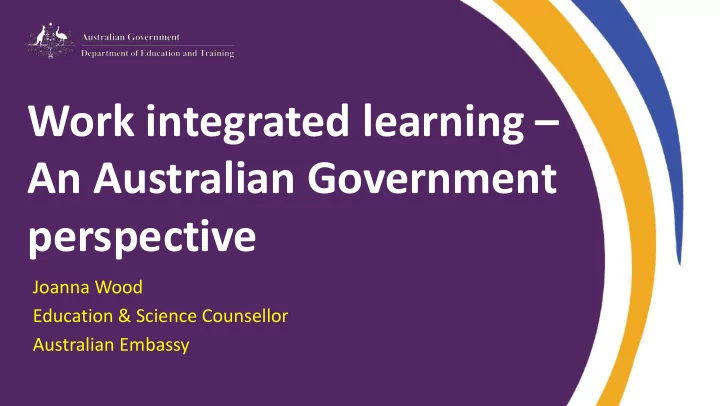

Work integrated learning – An Australian Government perspective Joanna Wood Education & Science Counsellor Australian Embassy
Australia’s Education System School Vocational Education & University Training 3.8 million students 4.2 million students 1.5 million students 9,444 schools 4,600 Registered Training 168 Tertiary Institutions • • 65% Government Organisations 43 Universities • • • 19.9% Catholic 54 public 125 Higher Education • • 14.5 % Independent 2,500 private Providers • 445 VET in school • 15 dual sector University Regulation National Regulation National Regulation State Government Australian Skills Quality TEQSA National Curriculum Authority (ASQA) Australia’s population: 25 million: Working Age Population: 16 million (15-65 yrs)
The Case For Action World of work is changing … • A 15 year-old of today is likely to have 17 different employers across their working lifetime • The type of work is changing • Non- technical ‘enterprise skills’ are more important than ever • Labour mismatch – skills in demand vs supply 3 Source: Foundation for Young Australians – The New Basics (2016)
SCHOOL
What are the Challenges and How to Respond? • Committed under the Quality Schools, Quality Outcomes policy to address career education. – Preparing Secondary Students for Work framework – National Career Education Strategy – The P-Tech pilot program – building connections to STEM study and employment pathways
The National Career Education Strategy • The Australian Government allocated $3 million to develop a National Career Education Strategy aimed at ensuring school students are ‘work ready’ and prepared for the jobs of the future. • Goals of the Strategy: – Support the development of effective career management skills. – Strengthen School and Industry collaboration. – Measure and track 21 st Century Skills, or General Capabilities as described in the Australian Curriculum 7
The Pathways-In Technology pilot program Geelong P-TECH Partnership – Newcomb Secondary College 8
Vocational Education & Training
Australia has a well established and dynamic vocational education & training system Features Number of students by location of training delivery • Strong industry engagement • Nationally agreed and consistent standards for training providers • Nationally agreed competency based qualifications defined by industry • Educational pathways : School, Vocational Education & Training, Higher Education • High employment rates for graduates Source: NCVER total VET Activity 2015 Report, July 2016
Good practice case studies and videos Australian school-based Apprenticeship videos • https://www.youtube.com/watch?v=P13NFlr -mFs 11
HIGHER EDUCATION
The National WIL Strategy 1. Provide national leadership to expand Work Integrated Learning (WIL) 2. Clarify government policy and regulatory settings to enable and support growth in WIL 3. Build support - among students, universities, employers across all sectors and governments - to increase participation in WIL 4. Ensure the investment in WIL is well targeted and enables sustainable, high quality experiences, stakeholder participation and growth 5. Develop university resources, processes and systems to grow WIL and engage business and community partners 6. Build capacity for more employers to participate in WIL 7. Address equity and access issues to enable students to participate in WIL 8. Increase WIL opportunities for international students and for domestic students to study off- shore. 13
Scaling the Sciences Australian Government National Research Internships Program ($28.2million 2016-20) • 1,400 industry based internships for PhD researchers • More women in STEM disciplines 15
Next Steps And Some Challenges Role of Australian Government: • Making data and information transparent • Harnessing partners – convening meetings • Providing seed funding where gaps are identified • Remove any funding disincentives • Addressing the regulatory impediments 16
www.education.gov.au
Recommend
More recommend